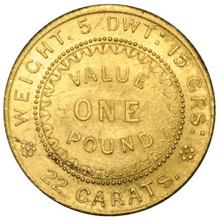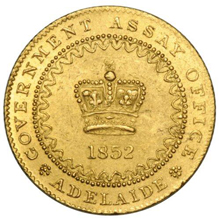 Australia's first legal tender gold coin was the Adelaide One Pound struck from Australian gold and dies made locally at the Government Assay Office in South Australia. There was a shortfall of coins in the mid 1800's because of the gold rush and the newly populated colonies. The government needed a way of converting gold nuggets to currency. The bullion act was therefore amended to allow the assay office to strike Ten Shilling, One Pound and Five Pound gold coins. Only the One Pound gold coin ended up being struck for circulation. In the early 20th century the Melbourne branch of the Royal Mint struck a very small number of the Five pound coin, and it is believed that just two are still in existence. One of these coins was sold in 2009.
Australia's first legal tender gold coin was the Adelaide One Pound struck from Australian gold and dies made locally at the Government Assay Office in South Australia. There was a shortfall of coins in the mid 1800's because of the gold rush and the newly populated colonies. The government needed a way of converting gold nuggets to currency. The bullion act was therefore amended to allow the assay office to strike Ten Shilling, One Pound and Five Pound gold coins. Only the One Pound gold coin ended up being struck for circulation. In the early 20th century the Melbourne branch of the Royal Mint struck a very small number of the Five pound coin, and it is believed that just two are still in existence. One of these coins was sold in 2009.
In 1852 the first Adelaide Pound was struck without Royal assent. Because it wasn't given royal approval there is some conjecture over whether it can be officially called a coin and or whether it is just a coin shaped ingot guaranteed to be worth one pound. In late 1852 the coins were found to have a higher intrinsic value than the one pound face value (almost two shillings more of gold value) so they were withdrawn with a large number also exported by English profiteers to London where they were melted down for their gold content. Minting was ceased on 13th Feb 1853. After this Royal refusal of the minting was received but by then the coins had already been minted, served their purpose and been withdrawn. Following this a branch of the Royal Mint was setup in Sydney and they started production of gold sovereigns.
 There are two types of the Adelaide pound. The Type One, with a cracked die and the Type Two with the revised die. Coins have been sold in the past ten years for between $10,000 and $325,000 for a Gem Uncirculated. Fraudulent examples of this coin have been found struck from dies and more crudely cast examples have been passed as genuine.
There are two types of the Adelaide pound. The Type One, with a cracked die and the Type Two with the revised die. Coins have been sold in the past ten years for between $10,000 and $325,000 for a Gem Uncirculated. Fraudulent examples of this coin have been found struck from dies and more crudely cast examples have been passed as genuine.
Type One. With a beaded inner circle on the reverse minted approximately fifty coins before a die crack appeared at 12 o'clock rendering the die useless. Only thirty examples of this type designed by Joshua Payne are thought to have survived today rarely being offered for sale.
Type Two. With a new die, 24 648 pieces minted but as many were removed from the colony and melted down it is thought that as few as 200 have survived today. The reverse on this type differed by having a crenellated inner circle.